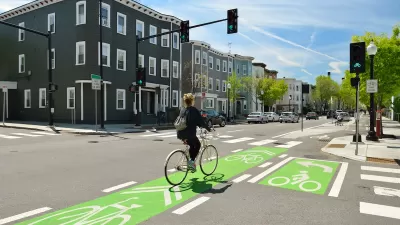The National Transportation Safety Board has released documents related to the Tempe, Arizona, crash that killed a person, highlighting what went wrong with the driverless technology.

"The software inside the Uber self-driving SUV that killed an Arizona woman last year was not designed to detect pedestrians outside of a crosswalk, according to new documents released as part of a federal investigation into the incident," report Aarian Marshall and Alex Davies. But the documents, posted by the National Transportation Safety Board, point to the bigger problem of self-driving technology not being able to understand and anticipate how humans actually behave.
In addition to safety training issues, the documents suggest a series of software-related detection, braking, and vehicle speed problems that contributed to the crash. "When the car first detected [Elaine Herzberg’s] presence, 5.6 seconds before impact, it classified her as a vehicle. Then it changed its mind to 'other,' then to vehicle again, back to 'other,' then to bicycle, then to 'other' again, and finally back to bicycle," say Marshall and Davies.
They note that road design was also a contributing factor in the crash since Herzberg was crossing with her bike "near a pathway that appeared purpose-built for walkers, but was 360 feet from the nearest crosswalk.” The NTSB will hold a meeting later this month about the incident with subsequent plans to release its full report.
FULL STORY: Uber’s Self-Driving Car Didn’t Know Pedestrians Could Jaywalk

Maui's Vacation Rental Debate Turns Ugly
Verbal attacks, misinformation campaigns and fistfights plague a high-stakes debate to convert thousands of vacation rentals into long-term housing.

Planetizen Federal Action Tracker
A weekly monitor of how Trump’s orders and actions are impacting planners and planning in America.

In Urban Planning, AI Prompting Could be the New Design Thinking
Creativity has long been key to great urban design. What if we see AI as our new creative partner?

King County Supportive Housing Program Offers Hope for Unhoused Residents
The county is taking a ‘Housing First’ approach that prioritizes getting people into housing, then offering wraparound supportive services.

Researchers Use AI to Get Clearer Picture of US Housing
Analysts are using artificial intelligence to supercharge their research by allowing them to comb through data faster. Though these AI tools can be error prone, they save time and housing researchers are optimistic about the future.

Making Shared Micromobility More Inclusive
Cities and shared mobility system operators can do more to include people with disabilities in planning and operations, per a new report.
Urban Design for Planners 1: Software Tools
This six-course series explores essential urban design concepts using open source software and equips planners with the tools they need to participate fully in the urban design process.
Planning for Universal Design
Learn the tools for implementing Universal Design in planning regulations.
Appalachian Highlands Housing Partners
Gallatin County Department of Planning & Community Development
Heyer Gruel & Associates PA
Mpact (founded as Rail~Volution)
City of Camden Redevelopment Agency
City of Astoria
City of Portland
City of Laramie




























